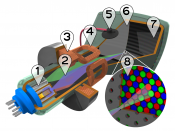It seems like one of the toughest questions that come up when someone is looking to buy a new piece of electronics is whether they should go with the old CRT standard or the new LCDs. If you ask around, the opinions you will hear are as varied as the people you ask. Currently, the two most common display types are the CRT (Cathode Ray Tube) and LCD (Liquid Crystal Display). Both monitor types have specific advantages and disadvantages associated with their operation. In order to better understand which display is more appropriate, it is important to gain an understanding of how the displays compare.
The first physical difference is screen size. Screen size is a big factor when choosing a product, but the reality is you should be looking at the viewing area instead. CRTs have rounded display tubes that actually reduce the viewing area of the unit, while LCDs are flat panels that have wider viewing areas.
For example, a 17" CRT actually measures 14.9" diagonally and a 15" LCD will measure 15" diagonally. So an LCD panel actually has a larger viewable are than a similar or even larger monitor.
Another decision to make is environment you'll be working around. Everyone knows that old Mother Nature can sneak up on you and put you in the middle of wet weather, sometimes at a moments notice. Are your electronics prepared for the inclement weather? Chances are, if you an LCD unit you are in the clear. Most LCD units are completely waterproof, but the same is not true for their CRT counterparts. If you plan on mounting your unit where it will get from rain, splash back or just being hosed down, then you will want the security of the LCD waterproof housing. The LCD also has...


